How can farmers become teachers and villages become classrooms? Quite easily and naturally in Nepal. Because they know the land and environment intimately, local farmers and villagers in eastern Nepal are helping to identify and preserve the country’s immense variety of flora and fauna.
Using the local knowledge of the people living there, the non-profit KTK-BELT Project was created in 2013 on Mt Kanchenjunga in the Himalayas, the world’s third tallest peak, with an elevation of 28,169 feet (around 8,585 metres). 
According to its founders, the KTK-BELT Project is a “platform for farmers, teachers, designers and environmentalists working together to build community-based biodiversity conservation strategies for the eastern region of Nepal.” To begin it helped establish a farmers’ cooperative called Yangshila Permaculture Learning Grounds and bought 100 acres of land in 20 locations at different altitudes to preserve ecosystem habitats and guard against deforestation. A “Vertical University” was thus set up, where the farmers teach local youngsters, biologist, other scientists and environmentalists about the region’s biodiversity. Each piece of land is a “living classroom” in which ecology and habitat conservation are taught and indigenous knowledge is perpetuated.
Yet the KTK-BELT Project is doing even more. Its website states that it “responds to current threats and opportunities in the eastern region of Nepal. It operates in three intersecting spheres: environmental education, sustainable livelihoods, and biodiversity conservation. We focus on youth, women and minorities, and on empowering subsistence farmers and local labor through training and systems design to meet the threats of climate change, extreme poverty and the degradation of biological diversity and wild habitats.”
| Cookie | Duration | Description |
|---|---|---|
| cookielawinfo-checbox-analytics | 11 months | This cookie is set by GDPR Cookie Consent plugin. The cookie is used to store the user consent for the cookies in the category "Analytics". |
| cookielawinfo-checbox-functional | 11 months | The cookie is set by GDPR cookie consent to record the user consent for the cookies in the category "Functional". |
| cookielawinfo-checbox-others | 11 months | This cookie is set by GDPR Cookie Consent plugin. The cookie is used to store the user consent for the cookies in the category "Other. |
| cookielawinfo-checkbox-necessary | 11 months | This cookie is set by GDPR Cookie Consent plugin. The cookies is used to store the user consent for the cookies in the category "Necessary". |
| cookielawinfo-checkbox-performance | 11 months | This cookie is set by GDPR Cookie Consent plugin. The cookie is used to store the user consent for the cookies in the category "Performance". |
| viewed_cookie_policy | 11 months | The cookie is set by the GDPR Cookie Consent plugin and is used to store whether or not user has consented to the use of cookies. It does not store any personal data. |
